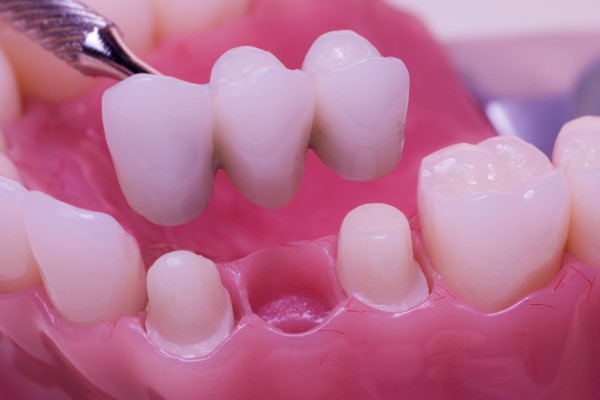Are Dental Bridges Effective for Replacing Missing Teeth?

Getting dental bridges is one of the popular ways to replace missing teeth. They are typically recommended when a person is missing about three teeth in a row. Dental bridges have two main components: abutments (crowns) that are placed on the two teeth closest to the gap and artificial teeth that replace the missing teeth (pontics).
Exploring the effectiveness of dental bridges as a replacement for lost teeth
Dental bridges restore the function of lost teeth and provide more stability than dentures. Bridges also require less maintenance than dentures. However, bridges do not provide certain benefits of other missing teeth replacement options, like implants with their bone-preserving properties. Here are a few important things that anyone who is thinking about getting dental bridges should consider.
1. A dental bridge does not stimulate the patient’s jawbone
When teeth fall out, their roots come out with them. These roots are connected to the jaw and hold the teeth in place in their sockets.
When a tooth falls out, the bone tissues that its roots were anchored to start to disintegrate due to a lack of stimulation. This leads to a thinning of the jawbone, and it can cause changes in a person’s facial structures. Dental implants serve as teeth roots and give bone tissues in the jaw the stimulation that they need to remain healthy.
2. A bridge can be placed in as little as two weeks
Getting a dental bridge typically involves two trips to the dentist. The first visit is used to prepare the teeth that will be covered with crowns and to take impressions of them. These impressions are sent to technicians in a dental lab, where restorations like dental bridges are made. The process takes about two weeks for the finished restorations to get back to the dentist. The abutments are covered with temporary crowns after the first visit, to protect them while the bridge and crowns are being made.
When the custom restoration is ready, the patient returns to the clinic for the second phase of their treatment. The temporary crowns are removed, and the crowns attached to the pontics are cemented into place. Alterations are made as needed to ensure that everything fits properly.
3. Dental bridges are easy to maintain
Unlike dentures, which require daily cleaning and soaking, bridges do not require specialized care. Brushing and flossing are all that these restorations need to stay in good condition. A good water flosser can make flossing with bridges easier.
Frequently asked questions about dental bridges
Let us look at the answers to common questions about dental bridges.
What are the various types of dental bridges available?
There are four main types of dental bridges: traditional, implant-supported, Maryland, and Cantilever. Traditional bridges are the most commonly used and are anchored down on the two teeth nearest to the space left by missing teeth.
An implant-supported bridge is similar to a traditional bridge, but it is anchored on implants next to the space instead of natural teeth. A Maryland bridge does not involve using crowns to anchor it in place; instead, it uses a framework that is glued to the back of the patient’s teeth. This makes Maryland bridges the least invasive variety.
A cantilever bridge is anchored only to one tooth next to the space. It is the least used type of crown because it provides the least stable base for the pontics.
Who needs an implant-supported bridge?
Implant-supported bridges are often recommended for people with bite issues due to missing teeth. They are also recommended for people who grind their teeth because the bridge evenly spreads the pressure across the pontics.
People who do not have enough bone thickness in their jaw to replace all their missing teeth can also benefit from implant-supported bridges. This way, the dentist only needs to find two spots with enough bone thickness to install implants. Patients should be healthy enough to recover from minor oral surgery to be eligible for implants.
How long does it take to replace missing teeth with dental bridges?
It usually takes about two weeks to replace missing teeth with bridges. This is about how long it takes for technicians in a dental lab to make the patient’s restoration and get it back to the dentist.
Replace your missing teeth
Are you ready to replace your lost teeth? Give us a call or drop by our Red Bluff clinic to set up an appointment with our dentist.
Request an appointment here: https://www.drelloway.com or call Randal S. Elloway DDS, Inc at (530) 527-6777 for an appointment in our Red Bluff office.
Check out what others are saying about our dental services on Yelp: Dental Bridges in Red Bluff, CA.
Related Posts
Prior to the use of CEREC equipment, getting dental prosthetics like crowns or veneers required multiple visits to the dentist. Thanks to new advances in technology, it is now possible for patients to get the dental restorations they need during a single visit.The traditional way of getting devices like crowns installed took somewhere between two…
Placing dental crowns is one of the most common dental procedures, and CEREC crowns ensure the process moves swiftly. The typical solution for someone needing a dental crown includes a few steps. It also includes more wait time.The mold for dental crowns is taken at the dentist's office and then they are typically sent to…
The dental industry and its technologies are constantly evolving and growing. As new techniques are brought into dentists' offices around the country, new terms and acronyms enter the lexicon.CEREC stands for Chairside Economical Restoration of Esthetic Ceramics and is a new technology that is used in saving patients both time and money.When someone is having…
A dental crown can restore a damaged, worn, or weakened tooth. This restoration can bring back your healthy smile and stable dental function. Knowing the benefits of dental caps can motivate you to set an appointment soon. Here are the benefits of a dental crown that you must consider.Losing a tooth can be annoying, especially…


